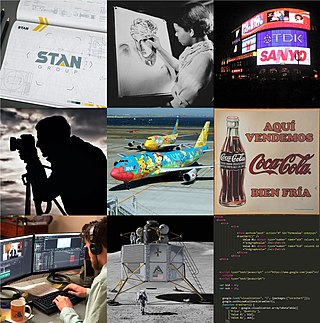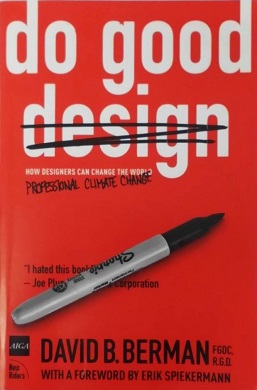The First Things First manifesto was written 29 November 1963 and published in 1964 by Ken Garland. It was backed by over 400 graphic designers and artists and also received the backing of Tony Benn, radical left-wing MP and activist, who published it in its entirety in The Guardian newspaper.
Reacting against a rich and affluent Britain of the 1960s, it tried to re-radicalize a design industry which the signatories felt had become lazy and uncritical. Drawing on ideas shared by critical theory, the Frankfurt School, and the counter-culture of the time, it explicitly reaffirmed the belief that design is not a neutral, value-free process.
It rallied against the consumerist culture that was purely concerned with buying and selling things and tried to highlight a Humanist dimension to graphic design theory. It was later updated and republished with a new group of signatories as the First Things First 2000 manifesto.

Graphic design is a profession, academic discipline and applied art whose activity consists in projecting visual communications intended to transmit specific messages to social groups, with specific objectives. Graphic design is an interdisciplinary branch of design and of the fine arts. Its practice involves creativity, innovation and lateral thinking using manual or digital tools, where it is usual to use text and graphics to communicate visually.

Vorticism was a London-based modernist art movement formed in 1914 by the writer and artist Wyndham Lewis. The movement was partially inspired by Cubism and was introduced to the public by means of the publication of the Vorticist manifesto in Blast magazine. Familiar forms of representational art were rejected in favour of a geometric style that tended towards a hard-edged abstraction. Lewis proved unable to harness the talents of his disparate group of avant-garde artists; however, for a brief period Vorticism proved to be an exciting intervention and an artistic riposte to Marinetti's Futurism and the post-impressionism of Roger Fry's Omega Workshops.
The First Things First 2000 manifesto, launched by Adbusters magazine in 1999, was an updated version of the earlier First Things First manifesto written and published in 1964 by Ken Garland, a British designer.

Constructivism is an early twentieth-century art movement founded in 1915 by Vladimir Tatlin and Alexander Rodchenko. Abstract and austere, constructivist art aimed to reflect modern industrial society and urban space. The movement rejected decorative stylization in favour of the industrial assemblage of materials. Constructivists were in favour of art for propaganda and social purposes, and were associated with Soviet socialism, the Bolsheviks and the Russian avant-garde.

Productivism is an early twentieth-century art movement that is characterized by its spare geometry, limited color palette, and Cubist and Futurist influences. Aesthetically, it also looks similar to work by Kazimir Malevich and the Suprematists.

An art manifesto is a public declaration of the intentions, motives, or views of an artist or artistic movement. Manifestos are a standard feature of the various movements in the modernist avant-garde and are still written today. Art manifestos are sometimes in their rhetoric intended for shock value, to achieve a revolutionary effect. They often address wider issues, such as the political system. Typical themes are the need for revolution, freedom and the implied or overtly stated superiority of the writers over the status quo. The manifesto gives a means of expressing, publicising and recording ideas for the artist or art group—even if only one or two people write the words, it is mostly still attributed to the group name.
The Euston Manifesto is a 2006 declaration of principles signed by a group of academics, journalists and activists based in the United Kingdom, named after the Euston Road in London where it had its meetings. The statement was a reaction to what the writers argued to be widespread violations of left-wing principles by others who were commonly associated with the Left. The manifesto states that "the reconfiguration of progressive opinion that we aim for involves drawing a line between forces on the Left that remain true to its authentic values, and currents that have lately shown themselves rather too flexible about these values".
Social design is the application of design methodologies in order to tackle complex human issues, placing the social issues as the priority. Historically social design has been mindful of the designer's role and responsibility in society, and of the use of design processes to bring about social change. Social design as a discipline has been practiced primarily in two different models, as either the application of the human-centered design methodology in the social sector or governmental sector, or sometimes is synonymously practiced by designers who venture into social entrepreneurship.
Rick Poynor is an English writer on design, graphic design, typography, and visual culture.
Herbert Spencer was a British designer, editor, writer, photographer and teacher. He was born in London.
Jessica Helfand is a designer, author, and educator. She is a former contributing editor and columnist for Print, Eye and Communications Arts magazine, and founding editor of the website Design Observer. She is Senior Critic at Yale School of Art since 1994, a lecturer in Yale College, and Artist-in-Residence at Yale’s Institute for Network Science. Named the first Henry Wolf Resident in design at the American Academy in Rome in 2010, she is a member of the Alliance Graphique Internationale and the Art Director’s Hall of Fame. In 2013, she won the AIGA medal.
The Discovery Institute has conducted a series of related public relations campaigns which seek to promote intelligent design while attempting to discredit evolutionary biology, which the Institute terms "Darwinism". The Discovery Institute promotes the pseudoscientific intelligent design movement and is represented by Creative Response Concepts, a public relations firm.
Jeffery Keedy, born 1957, is an American graphic designer, type designer, writer and educator. He is notable as an essayist and contributor to books and periodicals on graphic design. He is also notable for the design of Keedy Sans, a typeface acquired in the permanent collection of the Museum of Modern Art in 2011.

Jonathan Barnbrook is a British graphic designer, film maker and typographer. He trained at Saint Martin's School of Art and at the Royal College of Art, both in London.
The Manifesto of the Sixteen, or Proclamation of the Sixteen, was a document drafted in 1916 by eminent anarchists Peter Kropotkin and Jean Grave which advocated an Allied victory over Germany and the Central Powers during the First World War. At the outbreak of the war, Kropotkin and other anarchist supporters of the Allied cause advocated their position in the pages of the Freedom newspaper, provoking sharply critical responses. As the war continued, anarchists across Europe campaigned in anti-war movements and wrote denunciations of the war in pamphlets and statements, including one February 1916 statement signed by prominent anarchists such as Emma Goldman and Rudolf Rocker.

Do Good Design: How Designers Can Change The World is a book by Canadian designer David B. Berman, with a foreword by Erik Spiekermann, published by Peachpit Press in January 2009. The book was co-published by the American Institute of Graphic Arts (AIGA).
Ken Garland was a British graphic designer, photographer, writer and educator. Garland is known for his writing on design and the prolific work of his studio Ken Garland & Associates.
Edward Wright was a painter, typographer and graphic designer.
John Lewis (1912–1996) was a Welsh typographer, printer, illustrator and collector of printed ephemera.
Radojica Živanović Noe was a painter and graphic artist of the period of Surrealism and a writer. He left a small number of compositions, still lifes, landscapes and drawings. The most significant period of Živanović's artistic creation is his affiliation with the Surrealist movement (1930–33). He was one of the thirteen signatories of the Manifesto of Surrealism and the only professional painter in the group of artists who initiated the Belgrade Surrealist movement.